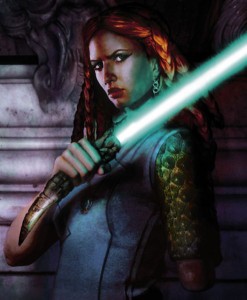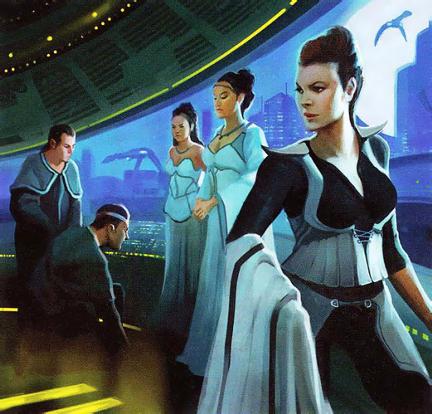Blood, Honor, and Matriarchs: The Hapan Women of Star Wars – Part One
One of the reasons science fiction and fantasy appeals to so many people is that it doesn’t shy away from exploring philosophical questions about our own worldviews. In the 1960’s, Star Trek posited a society where racism and sexism did not exist. Even though the storytelling and real-world casting couldn’t be truly reflective of this futuristic society free from intra-human bias, the television series was able to use alien cultures to effectively highlight how contemporary American society should self-reflect. Through the ‘70s and ‘80s, like many of its genre predecessors, the Star Wars Original Trilogy prodded its audience into seeing the world differently. The princess wasn’t just a damsel in distress; she helped spearhead a rebellion. A black man went from protector of his local community to a central hero in the fight to free all beings from oppression. Star Wars wasn’t perfect in its portrayals, either, but I’d argue science fiction and fantasy don’t aspire to be perfect.

Genre storytelling has to be a little rough around the edges because it reflects the realities of the world the audience lives in. When historians look back on this era, undoubtedly its fiction will expose the biases and conflicts that defined us. Nonfiction studies such as Jennifer K. Stuller’s book Ink-Stained Amazons and Cinematic Warriors or Gail Simone’s Women in Refrigerators webpage will give insights into how a broad range of storytelling across entertainment mediums reveal truths about the society that produced and consumed them. The success of Star Wars, Star Trek, Harry Potter, Twilight, and The Hunger Games all say something about who we are and what we want to be. Ultimately, that fiction may have the power to change us as a people more than anything else.
After reading Fate of the Jedi: Apocalypse, I kept coming back to a particular couple – minor players in the unfolding drama – who, through the craftsmanship of a talented writer, were used to express the realities of gender bias and yet simultaneously show how sometimes it is the small steps taken in interpersonal relationships that can help bring about change. The irony is that it wasn’t a man placing his worth above a woman, but rather a woman who had been raised from birth to believe she was better than a man. It’s genre work doing what it does best: using fictional cultures and races to bring awareness to inequality without being so in-your-face that it gets tuned out. While I have been a voice asking for storytellers and storytelling that brings the role of women up to level with the roles of men, I’m one among many. So I decided to bring in some of my fellow fangirls to talk about the potential we see in using the Hapan culture in future Star Wars novels.
“Never let a man become so deluded as to believe that he is the intellectual equal of a woman. It only leads him to evil.”
~ Hapan saying from The Courtship of Princess Leia
I think before we get started, it’s important to explain our perceptions of the culture and role of the Hapans within the context of the galaxy far, far away.
Racheal: Through the eyes of Han Solo in The Courtship of Princess Leia, the Hapans appear like an excessively rich culture with a need to display their personal wealth. Their riches are both frivolous (rainbow gems from Gallinore) and honorable (thought puzzle). It’s offering Prince Isolder’s hand in marriage, though, that gives the first memorable role reversal. How many times is the male hand given up? I can’t think of a single instance. The descriptions of the Hapans and behavior in various books remind me of Elizabeth Taylor in Cleopatra. The servants are there to serve the Queen and no one else. To do otherwise equals death. In the movie, one of the handmaidens notices that the servant tasting Cleopatra’s drink did not follow procedure. Cleopatra confronts the woman and forces her to drink it and the servant is poisoned. I can see this happening in the Hapan court.

There are times that I want to cheer at the matriarchal society. The Hapans tend to take the treatment of men too far though in making them nothing. This viewpoint provides a clearer view of the adverse effects of male-dominated society. If it were a male-led society, would the treatment of the opposite sex seem as bizarre? Doubtful.
The Hapans appear almost petty in their jealousy and treachery, but it isn’t any different from what other governments do. The number of coups alone tells enough about that.
The Hapans are human, yet seem almost alien. There’s no real information about how the common people live. Any time the Hapans come into play, the story feels a little broader culture-wise. Their different society allows for a new perspective in the EU.
Kay: I agree with Rachael that the Hapans have a Cleopatra-feel to them – both in displays of wealth and the goddess-like treatment of their ruler. I think there’s even more treachery in the Hapan court though as there are so many members of the family that see a possibility for each of them to claim the throne for herself. Part of what makes that treachery interesting is that they’re also a society with honor codes, which can and does come into conflict with the treachery.
And while I’m not personally a fan of the treatment of males versus females in Hapan culture, it does bring a different perspective to stories that involve them. It also means they bring no shortage of confident female characters. It’s my impression that the Hapan Navy is majority female as well as the Hapan Royal Guard and Hapan Intelligence. These women are all over the place and they rely on structure and hierarchy to get stuff done.
“The Hapes cluster was originally settled by pirates, a group called the Lorell Raiders. For hundreds of years they stalked the trade routes of the Old Republic, seizing ships, stealing cargo. And when they found a beautiful woman, some raider would take her as a prize to the hidden worlds of Hapes.”
~ Princess Leia to Han Solo in The Courtship of Princess Leia
Tricia: I think the honor of the culture works with the principles of pirate lore from non-genre storytelling. Pirates are thieves and bad guys, but they are usually represented as having a code, much like the bounty hunters have been protrayed in The Clone Wars this past season. These Lorrell Raiders took their sons, leaving the women behind, as they ventured beyond Hapan space, and most of them were killed by the Jedi. This left a power vacuum in their culture that the women stepped up and claimed, ultimately forming the matriarchy we see in the post-Return of the Jedi stories.
The Hapans don’t trust Jedi, for good reason. Yet the Jedi who created the opportunity for women to become the dominant gender within their culture. What do you think of this dynamic as it relates to the storytelling and culture building within the Expanded Universe?
Racheal: Given how the Hapans started, their trust issues make sense. Not only are Jedi unpredictable, but also they’re supposed to look at the bigger picture. The Hapans focus on their Cluster. When it comes to national pride, Hapans seem to have more of it than Corellians. Perhaps the Jedi did not help the woman after defeating the Lorell Raiders. Maybe the Jedi killed too many sons. Until that’s written – which I doubt will happen – it’s mostly speculation.
The writers forced the Hapans to adapt to Jedi – gradually. Teneniel Djo wasn’t trained, but could use the Force. Tenel Ka’s ascension makes the major difference. Unfortunately, we haven’t seen how having a full Jedi Knight on the throne has affected Hapan culture.
I think this dynamic has massive potential that’s rarely used. Logically, Tenel Ka would face challenges from those in her court because she is a Jedi. With all the Sith versus Jedi conflict or government versus Jedi, it seems as if the Powers That Be are ignoring plot opportunities.
Because the Hapan culture is so different compared to the rest, it forces a new look at whatever is going on. Ben’s rescue in Invincible by the Zel twins felt different because of how they didn’t care about his orders. He was just a boy. It could be seen as culture shock, which usually adds something to a story.

Kay: I would imagine when Tenel Ka expressed interest in being a Jedi over being the Chume’da, there would be many members of the Royal Family who would have been thrilled – more reason to dislike her and cast her out (on top of being half the daughter of an outsider) and without any siblings, more of a chance to gain power themselves. I’m not sure if that was really explored, though. As much of what we know of Hapan culture and how it differs from other prominent cultures in the EU, we usually get such a shallow perspective of Hapan reaction to events.
That being said, I’d think that honor code and the near-worship of the Queen Mother would, for the most part, protect Tenel Ka from anti-Jedi sentiments of the general public and upper class once she was on the throne. So I’m not sure overall Hapan perspective on the Jedi would change much; they’d just have to live with the situation until she abdicates or is removed.
As with many other cultures when the mistrust of another group has existed for so many generations, some members of the current generation may not grasp why the other group makes them uneasy outside of that is just the way it is. That may mean there’s less of a chance of Hapans, a fairly tradition-based group, losing that dislike of Jedi even though the women enjoy the benefits the original situation gave them. But it could also mean for some of them, that they’ve given up on disliking Jedi because they have no personal reason for it. All the life-attempts on whomever is the Queen Mother by would-be throne-seekers tells me they’d go after her Jedi or not – the Jedi part may just be a little extra motivation. And since Tenel Ka resigned from the Jedi, there’s more facets to how who she is relates to the culture. Would those who previously disliked her for being a Jedi be pleased with the change? Would it not matter to them because it wouldn’t change the fact that she was once a Jedi? So there’s definitely more to explore in stories unless the Powers That Be insist on keeping the current level of Hapan mystery.
 Tricia: Elaine Cunningham used Tenel Ka for a secondary character arc in Dark Journey. In that book, there is a great exploration of the Hapan/Jedi differences within Tenel Ka’s arc. The war with the Yuuzhan Vong threatened the Hapans from the outside, and at the same time internal conflict in the power vacuum left in the wake of Teneniel Djo’s death made the Hapans even more vulnerable. Tenel Ka had just lost Jacen Solo on the Myrkr mission. His supposed death had also sent her best friend Jaina Solo tumbling along a dark path. Then her mother is poisoned, and Tenel Ka did what she felt was necessary to save her people. Stepping forward to take the throne is a very noble, selfless act, especially since she knew that would mean leaving behind her life as a Jedi. With the Yuuzhan Vong fleet closing as Tenel Ka’s reign begins, the Hapans accepted the rule of a Jedi with little resistance.
Tricia: Elaine Cunningham used Tenel Ka for a secondary character arc in Dark Journey. In that book, there is a great exploration of the Hapan/Jedi differences within Tenel Ka’s arc. The war with the Yuuzhan Vong threatened the Hapans from the outside, and at the same time internal conflict in the power vacuum left in the wake of Teneniel Djo’s death made the Hapans even more vulnerable. Tenel Ka had just lost Jacen Solo on the Myrkr mission. His supposed death had also sent her best friend Jaina Solo tumbling along a dark path. Then her mother is poisoned, and Tenel Ka did what she felt was necessary to save her people. Stepping forward to take the throne is a very noble, selfless act, especially since she knew that would mean leaving behind her life as a Jedi. With the Yuuzhan Vong fleet closing as Tenel Ka’s reign begins, the Hapans accepted the rule of a Jedi with little resistance.
The Jedi and Hapans have been united against a common foe in more recent books, but I always wonder if their simmering animosity isn’t a great way to explore themes that are relevent to the struggles we see among different cultures in real life. In Outcast, there is some hint of problems between the Hapans and the Empire during Jag’s term as Head of State, but we never see that in play, most likely because it was intended to be exposed in Blood Oath, the book with the best cover that was never written.
If you want to condense the extremist mindset of sexism meshed with raw survival instincts, you need look no further than the Queen Mother Ta’a Chume. Do you see her as evil, or as clawing by any means possible to keep her position of power and her life?

Racheal: Ta’a Chume does an excellent job of seeming as if she works to ensure the prosperity of the Hapes Cluster. Killing her own family for the good of the throne may seem as if she’s the ultimate extreme patriot. She’s a combination of evil and selfish. All of her reasons go back to her. She wanted Teneniel dead. It doesn’t matter that she was raised to be devious and treacherous. She choseto try to kill off most of her family. She could keep her position of power without doing what she did.
Kay: For Ta’a Chume, what seems best for the Hapes Cluster oddly enough seems to directly align with what’s best for keeping her in power. It makes it hard to tell what motivates her more or if it’s all the same thing. Going after Teneniel, Tenel Ka, and Allana to prevent a Jedi/Force-user dynasty makes it seem like she’s protecting her prejudiced view of what is best for the Cluster. But when she tried to get Jaina Solo (also a Force-user) to take the crown in order to rule through her and then make her own way back to the throne, that seems like it’s more just for her. Whatever her motivation, her actions were far too calculated to call clawing. There appears to be no line she was unwilling to cross. It’s obsession bred with the idea that absolute power corrupts absolutely.
Tricia: Ta’a Chume, for all her cunning, underestimated Jaina and Tenel Ka as she manuevered Jaina toward taking the throne. As I read her, Ta’a Chume had been forced to make some tough judgment calls early in her reign. The farther she gets from power though the more she seems willing to do anything to maintain it. She justifies her action in the name of Hapes, which if you look around our own history usually is the excuse wacky despots use to rationalize martial law, genocide, and all sorts of reprehensible acts.
The Courtship of Princess Leia ends with Ta’a Chume’s son Prince Isolder marrying Tenenial Djo, a Force-sensitive from Dathomir, another culture within Star Wars where women are the dominant gender. Yet the ideals of these cultures don’t necessarily mesh.
Racheal: Given that the Hapans consider the Dathomirians degenerates, it seems as if they are in denial about their similarities. Hapans thrive on being better than everyone is. Being compared to a group that hunts for their own food probably seems like an insult. It’s easier to considers a person’s actions, no matter how similar, worse than your own if you think you’re better than they are.
Kay: I agree. The Dathomirians are way too rough and tumble for fancy-pants Hapans to consider them similar. Beyond any dominant gender group though, both cultures feature strong, resilient women who like to get things done efficiently.
Tricia: Personally I find the parallels fascinating, yet the two societies are still vastly different. When the Hapan matriarchy came into rule, they were much farther along the technological evolutionary chain. It’s really the level of civilized living that makes the two cultures clash. Dathomir is a wilder, harsher planet. The tribal, nomadic culture there reminds me of what I saw in Tanzania, where the climate and terrain are brutal. Obviously reversed in that women are the physically dominant gender. The Clone Wars explored the tribal structure in Season 3, when Savage Opress was introduced. Those were the Katie Lucas written episodes. I’m hoping at some point in the future Star Wars will continue to utilize these types of cultures, including exposing the weakness with an oppressive and blindered mindset and also hopefully showcasing how individuals can overcome hurdles such as gender inequality imbalances.
Coming up, Racheal, Kay and I will talk more about Tenel Ka, Allana, Taryn Zel, Zekk, Allana, Blood Oath, and the secret society alluded to in Apocalypse. Expanded Universe quotes for this discussion were pulled from the Wookieepedia page on Hapans.
Racheal spent her childhood wishing to be like Princess Leia. She works as a freelance writer and copy editor and maintains a blog Galactic Drift that discusses Star Wars and other “nerd” activities. As her parents say, she’s been a feminist since the age of five, often telling the boys in kindergarten that girls could play with the “boy toys.” She lives in central Indiana with her husband, two cats, dog and bird.
Kay grew up wanting to be an astronaut. After seeing Star Wars, she wanted to be Princess Leia, Han Solo, and an astronaut. Life’s taken her on a bit of a different path for now, but she’s still a Star Wars fangirl at heart who enjoys surprising people with how geeky she really is. Currently a photographer who also specializes in communications and marketing, Kay spends her free time reading, cooking, writing, learning and, of course, making pew pew noises.
- Let’s Win the Season of the Force Scavenger Hunt - April 10, 2024
- Hyperspace Theories: Metamorphosis and Sacrifice in The Bad Batch Season Two - March 22, 2024
- Fangirls Going Rogue: The Bad Batch Returns - March 1, 2024










Pingback:Let’s talk about the Hapans | The Galactic Drift
Pingback:Utini Shout Outs! « Roqoo Depot
Pingback:Feminism and Star Wars: A Discussion of the Sexualization of Female Characters « fangirlblog.com